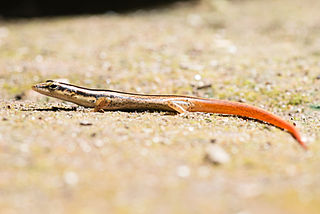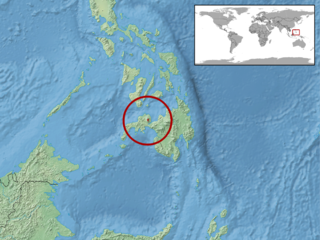
Lipinia is a genus of skinks, lizards in the family Scincidae. Species in the genus Lipinia are commonly called lipinias.
Edward Harrison Taylor was an American herpetologist from Missouri.

Boisea trivittata, also called the eastern boxelder bug, box bug, or maple bug, is a species of true bug native to eastern North America. The western boxelder bug Boisea rubrolineata is a relative of this species and is native to western North America. Eastern boxelder bugs are found primarily on boxelder, other maples, and ash trees.
The big-eared lipinia is a species of skink in the family Scincidae. It is endemic to the Andaman and Nicobar Islands of India.

Ameerega trivittata, formerly Epipedobates trivittatus, is a species of frog in the family Dendrobatidae commonly known as the three-striped poison frog. It is found in Bolivia, Brazil, Colombia, Guyana, Peru, Suriname, Venezuela, possibly Ecuador, and possibly French Guiana.

The Burmese roofed turtle is one of six turtle species in the genus Batagur of the family Geoemydidae. It is a freshwater turtle that is endemic to the rivers of Myanmar. It was once a common and abundant turtle in its respective habitat. As populations began facing rapid decline, eventually the species was thought to be extinct, until two subpopulations were rediscovered in 2001 in the Chindwin and Dokhtawady rivers. Less than 10 mature individuals were known by 2018. The Burmese roofed turtle is one of the most critically endangered turtle species in the world.

Ilyanassa trivittata, common name the threeline mud snail, is a species of sea snail, a marine gastropod mollusk in the family Nassariidae, the Nassa mud snails or dog whelks.

Batagur is a genus of large turtles from South and Southeast Asia. All members of the genus are seriously threatened. With a 2007 merger with members from two other genera, this genus has six described species.

Lipinia vittigera, the banded lipinia, Sipora striped skink or common striped skink, is a species of skink in the genus of Lipinia native to Myanmar, Thailand, Vietnam, Malaysia, Singapore and Cambodia.

Lipinia vulcania, also known as the vulcan lipinia, is a species of skink endemic to the Philippines. It is known from two specimens: the holotype was collected at ca. 1700 m above sea level on Mindanao Island in 1857, and another one in southern Luzon in 1956.
Lipinia rouxi, also known as Roux's lipinia, is a species of skink. It is endemic to New Ireland, in the Bismarck Archipelago of Papua New Guinea.

Lipinia auriculata, also known as the Taylor's lipinia, is a species of skink. It is endemic to the Philippines.
Lipinia cheesmanae, also known commonly as Cheesman's lipinia and Cheesman's moth skink, is a species of skink, a lizard in the family Scincidae. The species is endemic to Indonesia.
Lipinia leptosoma, also known as the slender lipinia or Pandanus skink, is a species of skink. It is endemic to Palau.

Werner's lipinia is a species of skink found in Indonesia.

Rabor's lipinia or black slender tree skink is a species of skink found in the Philippines.
Vinciguerra's lipinia is a species of skink found in Indonesia.

Semper's lipinia is a species of skink found in the Philippines.

Lipinia zamboangensis, also known as the Zamboang lipinia or rusty tree skink, is a species of skink endemic to Mindanao, the Philippines.












